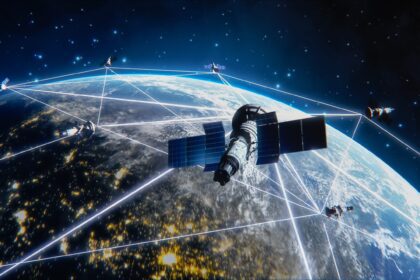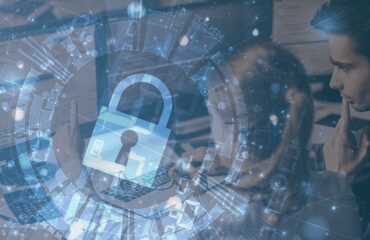
In an era where satellite communication underpins our interconnected world, ensuring strong cybersecurity and maintaining space sustainability has become crucial. Satellites play vital roles in global communications, navigation, environmental monitoring, and military operations. As we depend more on this technology, it’s essential to understand and address the complexities of securing these systems and preserving the space environment.
The satellite communication landscape: GEO, LEO, and MEO
Satellite communication systems are classified by their orbits: Geostationary Earth Orbit (GEO), Low Earth Orbit (LEO), and Medium Earth Orbit (MEO). Each orbit offers distinct advantages and challenges in terms of coverage, latency, and application suitability.
Geostationary Earth Orbit (GEO) satellites are positioned approximately 35,786 km above the equator. One satellite can cover about one-third of the Earth’s surface. This makes it ideal for broadcast services, weather monitoring, and certain communication applications where latency is less critical. However, the high latency of around 240 ms round-trip, due to the long signal travel distance, and limited capacity makes GEO less suitable for real-time communications and low-latency applications.
Low Earth Orbit (LEO) satellites operate between 180 km and 2,000 km above the Earth. These satellites need a large constellation to provide continuous global coverage. Their proximity to the Earth results in low latency, approximately 20-40 ms round-trip, making them ideal for real-time applications such as voice and video communications, IoT, and low-latency internet services. However, maintaining coverage requires many satellites, leading to potential congestion and sustainability issues in space.
Medium Earth Orbit (MEO) satellites are positioned between 2,000 km and 35,786 km above the Earth. They balance the extensive coverage of GEO with the lower latency of LEO. With moderate latency of around 50-150 ms round-trip, MEO satellites offer a compelling mix of coverage, capacity, and latency. This makes them suitable for applications like GPS, broadband services, and certain military communications. Although MEO systems require fewer satellites than LEO, they still face challenges related to space debris and the need for precise positioning and maintenance.
The unique advantages of LEO satellites
LEO satellites offer several advantages that make them ideal for specific applications.
- Low latency: Due to their proximity to the Earth, LEO satellites have a low latency of about 20-40 ms round-trip. This makes them perfect for real-time applications like voice and video communications and IoT where quick data transmission is critical.
- High data throughput: LEO satellites can provide higher data throughput compared to GEO satellites. This is because the shorter distance signals have to travel results in faster communication, which is beneficial for services that require high-speed data transfer.
- Global coverage: A large constellation of LEO satellites can provide continuous global coverage, ensuring that remote and underserved areas have access to communication services. This is particularly important for bridging the digital divide and providing connectivity in regions lacking terrestrial infrastructure.
- Scalability and flexibility: LEO satellite networks can be expanded by adding more satellites to the constellation. This flexibility allows service providers to increase capacity and coverage as demand grows, ensuring that the network can adapt to changing needs.
- Resilience and redundancy: The use of multiple LEO satellites creates a resilient network. If one satellite fails, others can cover its area, ensuring continuous service. This redundancy enhances the reliability of communication services.
Ensuring cybersecurity in satellite communications
As reliance on satellite communication grows, so does the threat landscape. Cybersecurity for satellite systems involves protecting ground stations, communication links, and the satellites themselves from a range of cyber threats, including jamming, spoofing, hacking, and data breaches.
Key cybersecurity strategies include encrypting all data transmitted between satellites and ground stations to prevent interception and unauthorised access. Implementing robust authentication protocols to verify the identity of users and devices accessing the satellite network is also crucial. Designing satellite systems with redundancy and failover mechanisms helps maintain operations in the event of a cyberattack or system failure. Additionally, continuously monitoring satellite networks for suspicious activities and having rapid response plans in place to address potential threats are essential for maintaining cybersecurity.
Promoting space sustainability
A recent article stated, that space debris poses a significant risk to operational satellites, potentially leading to collisions and the creation of even more debris.
Strategies for promoting space sustainability include designing satellites and launch vehicles to minimise the creation of space debris. This can be done by using deorbiting technologies to safely remove defunct satellites from orbit. Implementing advanced tracking and maneuvering systems to detect and avoid potential collisions with debris and other satellites is also critical. Collaborating with international space agencies and organisations to establish guidelines and best practices for sustainable space operations is essential. This ensures the long-term sustainability of space activities.
Satellite communication is becoming increasingly integral to our daily lives. We must proactively address the dual challenges of ensuring cybersecurity and maintaining space sustainability. Implementing robust cybersecurity measures and sustainability practices will help safeguard our space environment for future generations.
At Simoco Wireless Solutions, we are committed to advancing satellite communication technologies that are secure, sustainable, and capable of meeting the diverse needs of our interconnected world.
For more information on how our solutions can enhance your capabilities, please Click Here.
